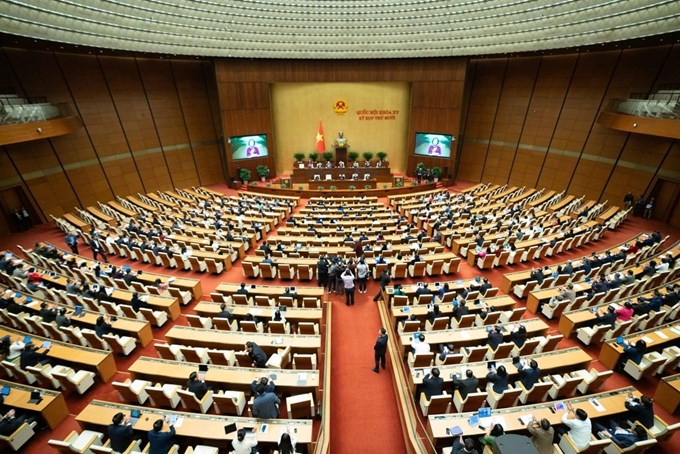National Assembly Deputy Nguyen Thi Lan proposed adding special mechanisms to attract human resources to the agriculture, forestry, and fisheries sectors, in order to address the shortage of high-quality personnel.
During the National Assembly’s discussion session on the Draft Resolution on several special and breakthrough mechanisms and policies to promote development in education and training, Prof. Dr. Nguyen Thi Lan (Hanoi Delegation) commended the drafting body for proposing modern, feasible, and forward-looking solutions.
She emphasized that the current draft reflected a clear shift in innovative thinking, from human-resource development mechanisms to the design of educational programs and policies related to science and technology.

The National Assembly discusses the Draft Resolution on several special and breakthrough mechanisms and policies aimed at creating transformative progress in education and training. Photo: Quochoi.vn
Significant Innovations in Human Resource Development and Educational Programs
According to Deputy Nguyen Thi Lan, the proposed mechanism for human resource development was now more flexible, granting provincial Departments of Education and Training greater autonomy in personnel management, while vocational and higher education institutions enjoyed enhanced self-governance in staffing.
Simultaneously, incentive policies for teachers had become more practical, with preferential allowances raised by 70-100% and mechanisms allowing institutions to autonomously increase income. “This is an important breakthrough, addressing longstanding bottlenecks and improving the status and living conditions of educators,” she stressed.
The draft also introduced improvements in curriculum development and educational services, such as streamlined procedures for adopting advanced international programs, free provision of textbooks according to a phased roadmap, and tuition exemptions for national defense and security education courses. These policies, Deputy Nguyen Thi Lan noted, were “humane, helping to reduce the financial burden on learners, and align with international integration requirements.”

Prof. Dr. Nguyen Thi Lan (Hanoi Delegation) speaks at the National Assembly plenary session. Photo: Quochoi.vn.
In the area of science, technology, and innovation, the draft allowed the capitalization of intellectual property assets, the formation of spin-off enterprises, expanded cooperation with enterprises, and gave priorities of investment and land to educational institutions. These, she added, were crucial for universities to become the hubs of innovation and gain more resources to develop sustainably.
Policy Gaps for Agriculture, Forestry, and Fisheries
Despite acknowledging the strengths of the Draft, Deputy Nguyen Lan highlighted a “notable policy gap,” particularly concerning human resources in agriculture and other essential yet difficult-to-attract sectors.
She pointed out that while the draft provided robust incentives for culture, arts, health sciences, and other special sectors, agriculture-forestry-fisheries, the backbone of the economy and national food security, had not been provided with a commensurate support mechanism.
Key disciplines such as soil science, crop science, animal science, plant protection, agricultural economics, agribusiness, rural development, agricultural extension, disaster prevention, fisheries, forestry, post-harvest technology, and water-resource engineering all struggled to attract students, despite strong societal and industry demand. The main reasons included the demanding nature of the work, relatively low income levels, and the absence of sufficiently strong incentives.
Deputy Nguyen Thi Lan noted that countries such as South Korea, Singapore, Israel, Australia, and EU members had solved this challenge through targeted scholarships, guaranteed employment, training contracts, professional allowances, strong university–enterprise partnerships, and strategic rebranding of agricultural careers. When policies were robust and long-term, even “unattractive” disciplines could draw large numbers of learners.
Based on this international experience, she recommended that the resolution should add several important mechanisms such as targeted scholarships, preferential loans for students in key agricultural fields, training contracts, increased investment in laboratories and practice facilities, and strengthened partnerships between universities and enterprises to ensure employment after graduation.

An overview of the November 20 session. Photo: Quochoi.vn
“Agriculture is the backbone, its workforce must be prioritized accordingly”
Another issue emphasized by Deputy Nguyen Thi Lan was the lack of a mechanism for forecasting human-resource demands by sector. She cited the current mismatch between supply and demand, specifically: some fields attracted large numbers of students despite limited job opportunities, while essential areas, such as food security, resource management, disaster responses, and sustainable agriculture, were facing serious shortages of high-quality personnel.
Drawing on the experiences of the EU, South Korea, and Singapore, where workforce forecasting systems effectively guided enrollment and resource allocation, she proposed assigning the Government the task of developing and regularly publishing human-resource forecasts as a foundation for educational planning.
Deputy Nguyen Thi Lan concluded that the Resolution, with its long-term vision and strong innovations, would lay an important foundation for breakthroughs in education and training, helping to secure high-quality human resources for national development, particularly in agriculture because argiculture was the backbone of the national economy.